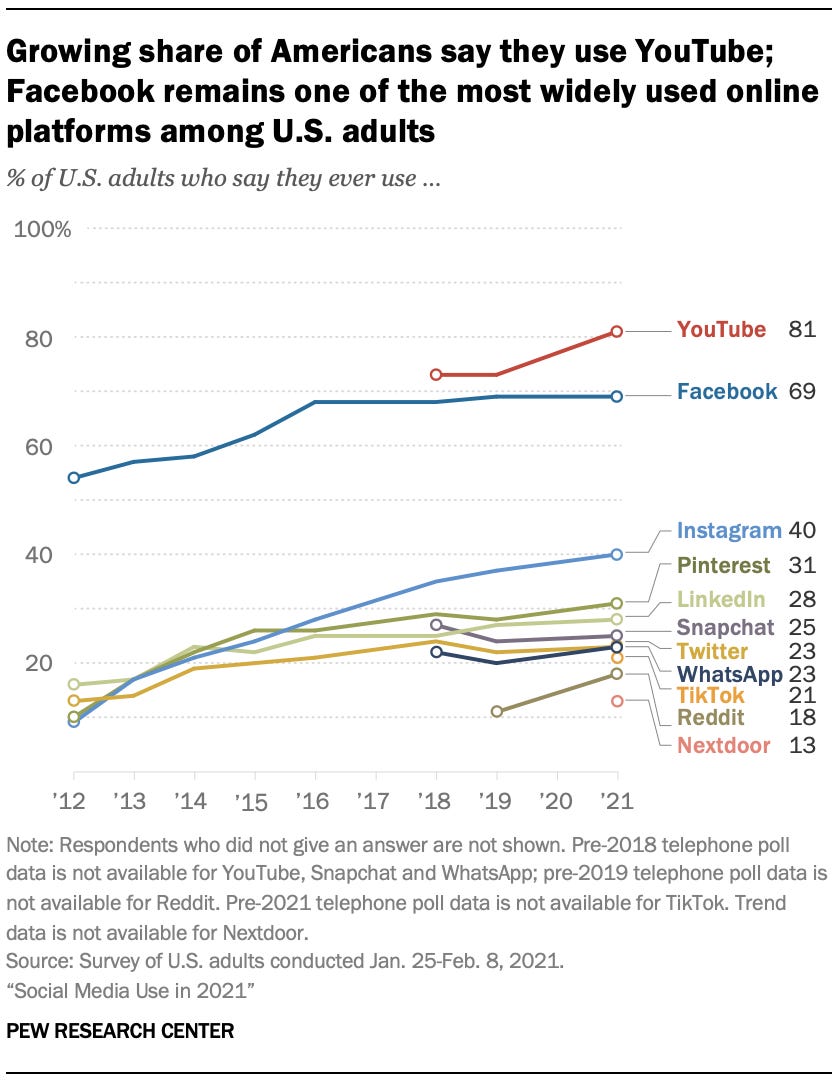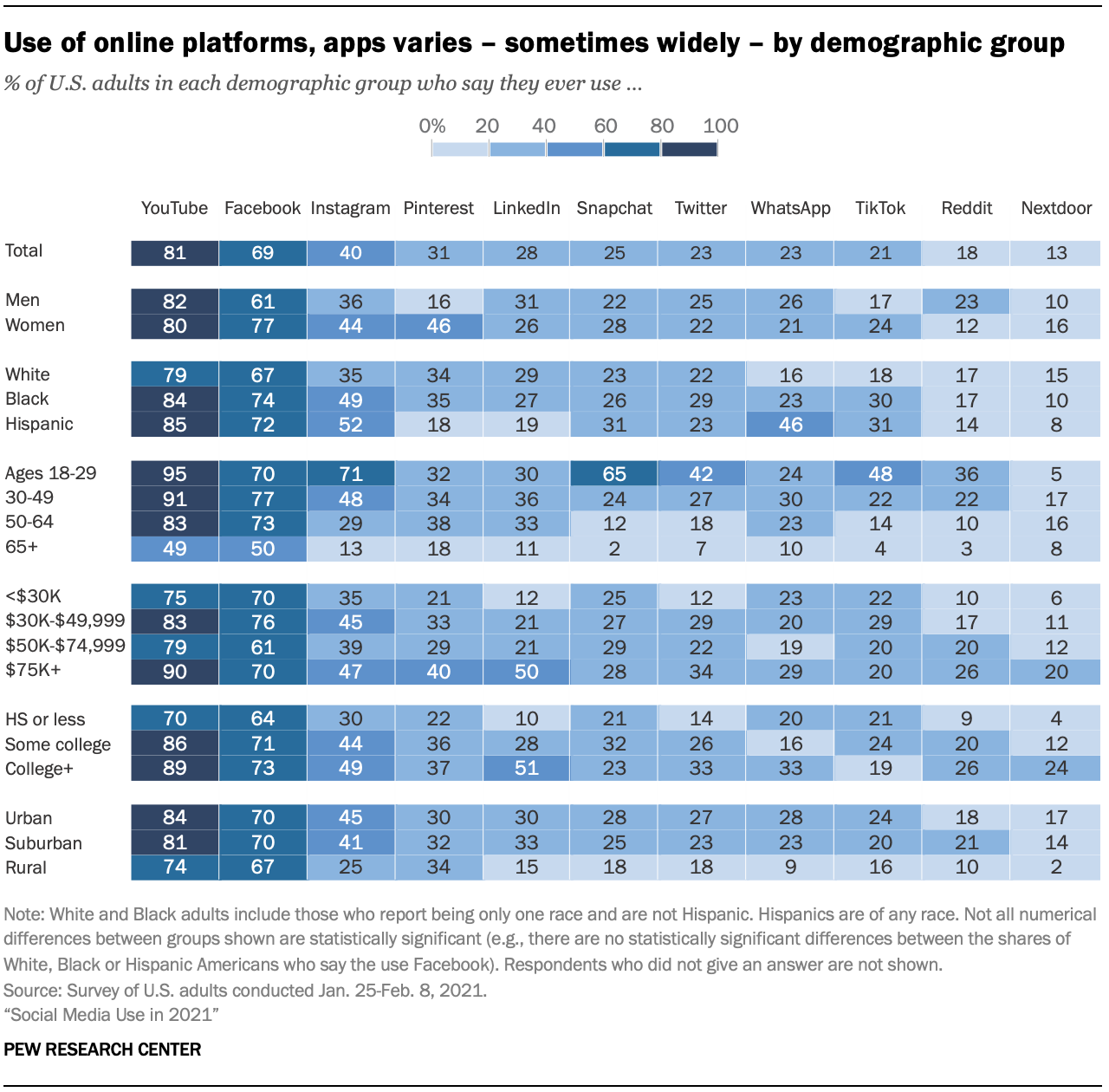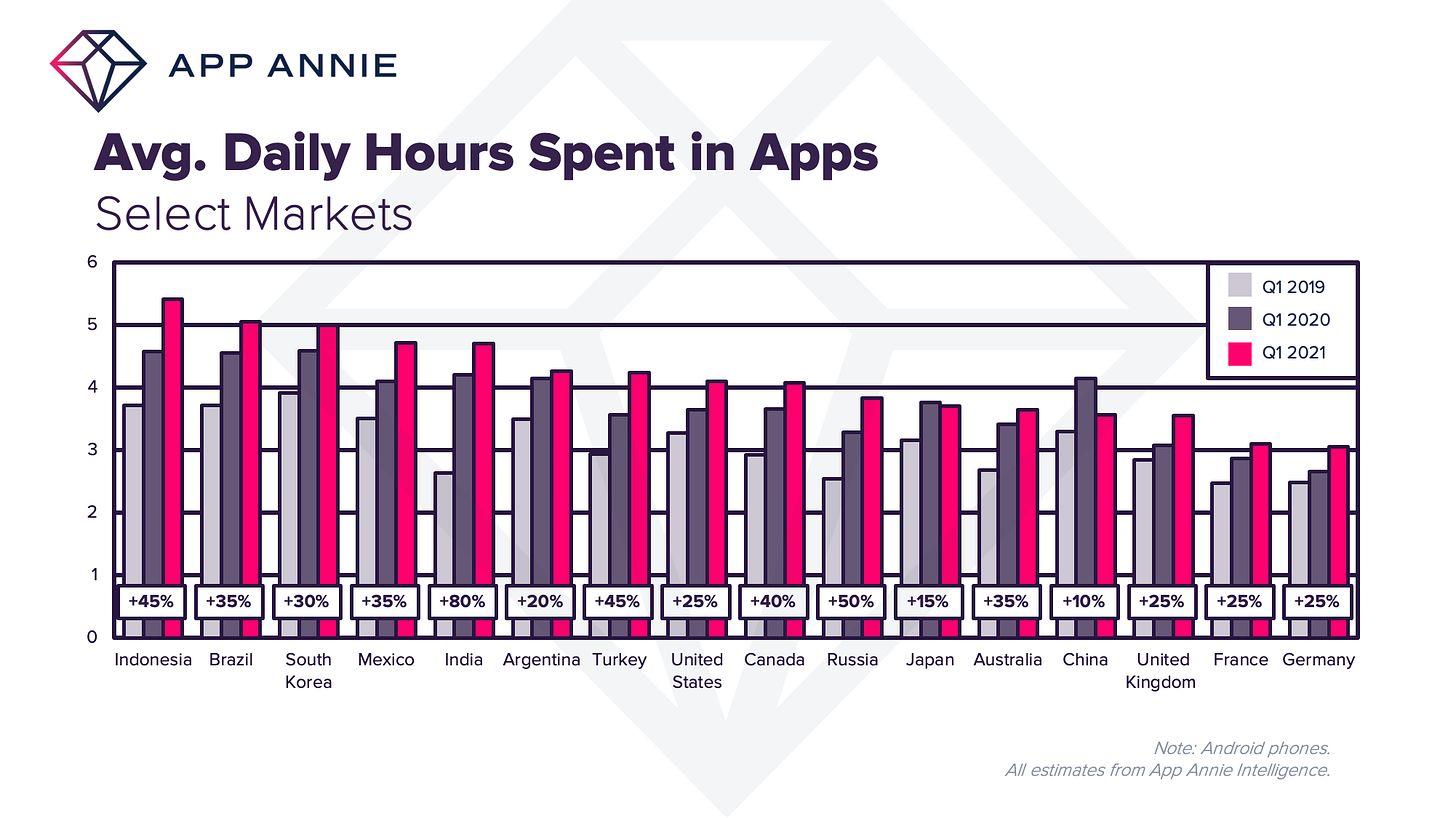The Social Media Report #21
One year into lockdown, the numbers are in
In this edition we take a look at the data coming through on how media consumption has changed during the last 12 months, with two reports released this week which look at both mobile phone app use, and social media trends. We also have as usual my must-read articles of the week.
Subscribe below if you’ve been sent this, and you’ll get every edition soon as it’s out.
We used social media more in the last 12 months, and we also stared at our screens more than we used to. It doesn’t take a rocket scientist to confirm that. But data published in the last week by Pew Research and by App Annie respectively sheds some light on precisely how our digital media consumption has changed due to lockdown.
Let’s look at social media use first. According to the latest report published by Pew Research, the growth in the last year of key social media platforms has led to YouTube stretching its lead over Facebook at the number one for adults in the U.S. According to the new data, 81% of U.S. adults say they use YouTube, up from 73% in 2019, a widening of YouTube’s lead over Facebook which was in second place, with 69% of U.S. adult users, a figure which did not rise or fall since 2019. Instagram is in third place at 40%.
Video and niched show growth: what I think is interesting here is not just the growth in the top guns, but the trend for growth in niche areas. With Facebook and Twitter plateauing, but YouTube and TikTok growing, notable growth platforms included Reddit, which grew 11% since 2019, and Pinterest 4%.
Going deeper, for example looking at the 18-25 year-old demographic, YouTube is near ubiquitous, with 95% of U.S. adults counting themselves as users, the highest score for any social network in any demographic. For comparison, TikTok’s highest score is 48%, with 18-25 year-olds, where Instagram scores 71% and Snapchat scores 65%.
On to apps. New data published by App Annie shows that global app use has increased 30% since 2019, with the average mobile phone user spending 4.2 hours each day on phone apps. With consumer attention increasingly rising and app use on the rise, markets such as India (a whopping 80% growth since 2019), Russia (50%) and Indonesia (45%) are leading the charge.
In terms of sheer amount of time now spent online on apps, Indonesia and then Brazil both clock in at at over five hours a day.
With more time spent staring at our screens, what I think is important here is not just how much we’re using apps, but what we are using them for. According to the App Annie data, banking and finance is on the rise, such as investing apps, in addition to short form video and messaging apps being the break-out sectors. The top break-out app according to App Annie is MX TakaTak, India’s version of TikTok.
Taking the macro view: what all these data sets, together, show. What these two pieces of research together show is important, because the picture is different to what social networks themselves ordinarily announce, with daily or monthly active user numbers being the norm. In these data sets, we are seeing the number of people who ever use a social media service, combined with time spent on phones.
To illustrate how this affects things. App use has grown, in some countries by 80%, and time spent is on a range of apps, from finance to social media. Some breakout apps could be incredibly sticky, and using up huge portions of users’ screen time. But these are in niches. While Intagram, TikTok and MX TakaTax, for example, could be dominating the time spent on phones for those who use the apps, the user base is not as broad as, say YouTube, which has reached 95% of young American adults. It’s about breadth and depth, and understanding user behaviour in order to see how demographics are now almost all dipping into some mainstream social media platforms, then dwelling in their niches.
In future editions of The Social Media Report, I am going to dive deeper into the content trends that shape each of the breakout social networks, both good and bad, as I feel this merits greater research.
My must reads from this week
Here are the stories that I have been reading this week.
Safety & society
The impact of beauty filters on society: a really powerful and worthwhile read on the history and the impact face filters have had on young women in particular, by MIT Tech Review’s Tate Ryan-Mosley.
Facebook’s Nick Clegg on whether we control the algorithm, or it controls us: you can guess which one he plumps for, and which one you come away believing. Linked: new research shows the Facebook algorithm shows different job ads to men and women.
Trends
India’s TikTok ban values rival ShareChat at $2bn: interestingly here, Twitter and Snapchat are investing in the India startup.
The rise of sleep-streaming: contributing to Twitch’s biggest ever month was the noted trend where streamers record themselves even while asleep, and, just like with TV, viewers watch while they nod off, too.
Audio
Reddit exploring audio features: I think ‘Clubhouse-style’ functionality would work really well on parts of Reddit.
The opportunity for Clubhouse: a podcast by Paul Sutton featuring my colleague Nicole Mezzasalma.
Reality
AR headsets the future of army training: Microsoft picks up $21bn augmented reality Hololens contract with the U.S. Army.
As Facebook’s virtual reality mission turns five: Wired takes a look at the VR efforts by Facebook, the challenges it is facing and the problems it has overcome.
Security
Twitch gets strict, even offline: the streaming platform has updated its policy even for offline harassment. [Linked: March 2021 was Twitch’s biggest month, with 2bn+ hours of video viewed]
16,000 groups on Facebook removed for trading fake reviews: the UK’s competition watchdog had to intervene twice before this happened.
500m LinkedIn profiles are being sold online: scraped public (but intendedly friend-visible) data from LinkedIn is now doing the rounds.
Work
A great thread on habits from the successful: love this from Chris Hladczuk, which includes ‘CTFU’ and build (and work) with your network.
Successful execs blend work & life: another great thread from Niantic’s Megan Quinn on one core observation from successful leaders, and it’s about flexible working patterns.
Where are people migrating to? U.S. postal service records show that the city where most Silicon Valley leavers have relocated to is Austin, Texas.
Long reads
The rise and fall of an industry in India based around missed calls: I thoroughly enjoyed reading this by Atul Bhattarai. Rest of World is doing some really great reporting, and the content in the story deserves a shout out too…
Updates
I spoke to Amelia Rope for her podcast, Hope & Patience, on the topic of being an entrepreneur in social media. It’s up on Spotify, here.
Back at HQ, Battenhall was named Global Social Media Consultancy of 2021, and UK Digital Comms Consultancy of 2021, in addition to an award for our work for NHS England on Instagram. We’re suitably chuffed :)
The Social Media Report is written by Drew Benvie, founder & CEO of Battenhall.
You can follow The Social Media Report on Twitter at @TheSMReport. Suggestions for stories can be emailed to db@battenhall.com. Thank you for reading, and see you next time.






